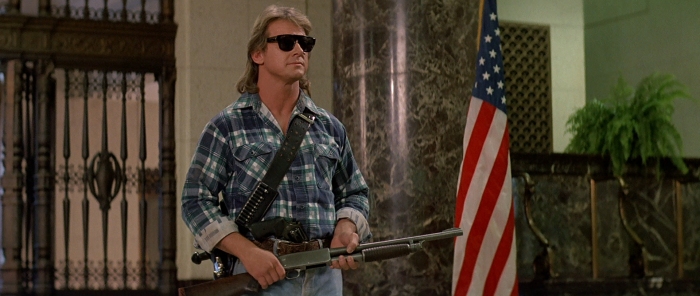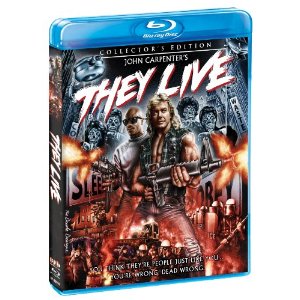They Live was a postmodern pastiche of old-school science fiction that, for a variety of reasons, was too ahead of its time to be properly appreciated. Actually, that’s not quite accurate. It was too of its time, in 1988, and it’s even more of its time, in 2012, and it will not reach its expiration date in 2022, or 3022, if They are still amongst us—or vice versa.
They Live is actually very similar, in many regards, to John Carpenter’s other misunderstood and inadequately touted masterpiece, The Thing (More on that film HERE.). The Thing, released in 1982, did not fare as well as it could—and should—have and like They Live, it endures as a cult classic. Where The Thing offered an indelible examination of paranoia it was also an eerily prescient, if quite direct and unintentional commentary on the AIDS crisis. They Live was an explicit condemnation of the Reagan years, and the fact that its release virtually coincided with the country’s decision to effectively give him four more years, with George Bush as the delivery device for an extended “morning in America”, suggests some reasons it did not fully connect.
There are other reasons the movie struggled to find a wider audience. It’s too dark and truthful to be taken as satire; it’s too (intentionally) outrageous, in parts, to satisfy the mainstream critics who take themselves more seriously than the work they do, and it doesn’t seek cheap or easy scapegoats. The bad guys, and what incents them, could not be more unmistakable, but the real scorn is reserved for those citizens who will say or do anything to earn admittance into their club. This ethos, of course, was alive and unwell long before and after The Gipper flew Air Force One. As such, They Live offers as blunt a critique of unfettered capitalism, taken to its (il)logical extreme, as has ever been committed to celluloid.
For those who don’t know or can’t remember, the movie’s plot is quite simple, but the levels of psychological and sociocultural observation are nuanced and rich. The great reveal (literally) is when the blind suddenly can see (figuratively), a black and white breakdown of epidemic consumerism. The garish billboards decoded to offer simple commands such as “Obey” and “Reproduce” are now legendary, and the use of aliens in our midst is employed as a whacky twist that hits disconcertingly close to home.
Of course it takes place in Los Angeles. The city where fantasy is manufactured, for money, every day. The cityscape that we see as the movie begins is the same one shown throughout and the one we ignore, avoid or rationalize: alleys, graffiti-laden bridges, piles of smoldering trash, swarming tenements, a makeshift tent community of anonymous faces, all in various states of distress. There are not enough jobs, there is not enough money, there is less than sufficient trust and next to no expectation except for the worst. Sound familiar? They Live was of its time, to be sure, in 1988. It was of its time in 2008, and it will never not be of its time, not in America.
For the most part, Carpenter lets this material play out the only way it can be played: surreal, scary and with no shortage of very black humor. In an early scene that might have seemed either throwaway or over the top, we see a young woman on TV baring the soul she’d love to sell: “I stop being myself and I’m the star of a series or I have my own talk show… all I ever have to do is be famous.” Ridiculous, clichéd, and a pretty perfect depiction of the sordid spectacle of contemporary reality TV (and, to varying if increasing extents, “regular” TV, including the news). Some people look at alien skull masks and see farce; other people see Donald Trump, Ryan Seacrest or Mitt Romney.
A few words about Roddy Piper, the man required to carry the movie on his beefy shoulders. I saw this in the theater and remember thinking at the time: If only they had just cast Kurt Russell (who was, at that time, kind of like John Carpenter’s DeNiro), what artistic and aesthetic import it might have had. I was mistaken, and a quarter-century has served to reaffirm Carpenter’s judgment. The first 30 minutes, perhaps, would be different, even better, with Russell (or another established A-list actor). But once the glasses go on, the film needs the levity and authenticity Piper conveys. Of course, as a famous wrestler, “Rowdy” Roddy Piper was quite accustomed to acting, showmanship and spectacle—all of which are called for throughout.
What results is satire, only supersized. Hence, “the scene”: that nine minute fight sequence is the movie, the entertainment industry and America itself, in miniature: incredible, hilarious, exaggerated. That we have a wrestler, using wrestling moves in a movie is almost too meta. This is probably why it didn’t quite play in 1988 and why it could never really work, anytime. It’s at once too ludicrous and too real (a couple of blue collar guys, beating each other’s brains out, as the world rots around them and a cabal of super-rich, well-insulated freaks goes about the business of doing business).
In the final analysis, They Live is like The Matrix without the billion dollar ballet routines. And it only needs about 90 minutes to strip the glossy carcass off consumerism, infotainment, political power structures (hint: our elected officials take their orders from corporations, not the other way around), serving it all up in a visionary smart bomb that touches on McLuhan, Chomsky, Goebbels, P.T. Barnum. Carpenter’s triumph is the way he somehow distilled the best of George Orwell and Edgar Allan Poe, disguising it as farce turned bloodbath. In the end the good guy wins. Then he dies.
The bonus footage is almost too good to be true, and fans of the film will need this without hesitation. There is an interview with the sagacious, self-deprecating John Carpenter, brief conversations with the perfectly cast co-stars Keith David and Meg Foster, and a brief “making of” feature. The real treat is the audio commentary provided by Carpenter and Piper, which is predictably enlightening and amusing. There is a clear and abiding bond the two men share, Carpenter glad he went out on a limb and Piper eternally grateful he was given the shot.
Two final nuggets. At one point Carpenter is asked if he ever considered shortening the infamous fight scene. “Fuck no!” he replies, defiant as ever. “The ‘80s never ended,” he opines. “They are still here, making more money than ever, they are still among us.” Meg Foster recounts walking to her car, years after the film was made, and hearing someone shout down to her from a fifth floor window: They Live!. “Yes, they do,” she says, smiling sadly. That exchange sums up everything that could be said then, and now.


